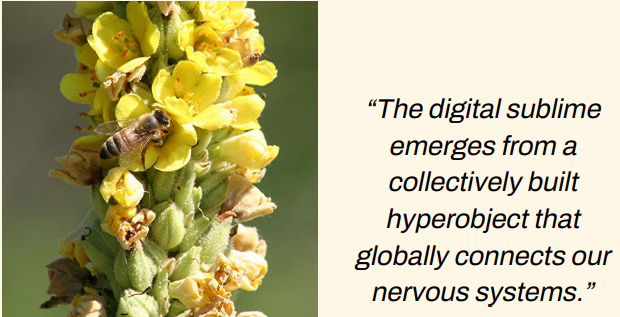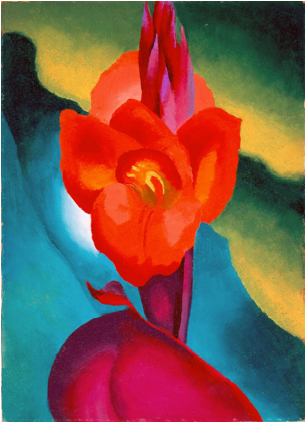17.2: Trailblazer
- Page ID
- 141528
Image Trailblazer: Sara Ludy

Figure \(17.11\) Images from nature inspire artists such as Sara Ludy (https://openstax.org/r/Sara-Ludy). (credit: “Plants OB 934” by USDA NRCS Montana/ Wikimedia Commons, Public Domain)
By the end of this section, you will be able to:
- Interpret images through the conceptual lens of hybridity to learn, think critically, and communicate in a variety of rhetorical and cultural contexts.
- Articulate how genre conventions are shaped by purpose, culture, and expectation.
Sara Ludy and Hybridity
This chapter focuses on images. Still, most of the images with which viewers interact have been either created or manipulated digitally (https://openstax.org/r/digitally) and contain textual, animated (https://openstax.org/ r/animated), and cinematic content. In the field of digital manipulation, Sara Ludy (https://openstax.org/r/ Sara--Ludy) is a pioneer, combining painting, sculpture, floral arrangements, animation, sound, and video. She was raised in Bluemont, Virginia, a small town in the Appalachian region. She studied at the School of the Art Institute of Chicago (SAIC) and lived and worked in New Mexico and California before settling in Chicago. Her work includes images of water, clouds, water vapor, birds, fabric, glass, and plants. American painter Georgia O’Keeffe’s (1887–1986) influence—see Figure \(17.12\)—on Ludy’s work is obvious in its lush, open petals and wings, as well as in the vibrant natural colors.

Figure \(17.12\) Red Canna, 1919, by Georgia O’Keeffe (credit: “Georgia O’Keeffe Red Canna 1919” by Georgia O’Keeffe/High Museum of Art, Atlanta/Wikimedia Commons, Public Domain)
But Ludy also names British primatologist Jane Goodall (b. 1934); Argentine writer Jorge Luis Borges (1899–1986); and American architect, inventor, designer R. Buckminster Fuller (1895–1983) among her inspirations, emphasizing the hybrid nature of her work. The concept of hybridity pervades Ludy’s work, which occurs in different media and includes a variety of topics.
The concept refers to mixing and is used in disciplines that encompass discussions of language, race, ethnicity, and culture. Relating to digital and visual media, the term hybridity incorporates pieces from each of these disciplines as well as the blending of practical, physical, technological, and artistic methods. The result is a piece of art that represents and speaks to people from multiple walks of life in various visual and tactile ways.
In particular, the concept of hybridity in the arts refers to the relationship between digital media and the creation and experience of the artwork. Artists such as Ludy anticipate that mixture by embedding it in their work, using digital techniques to distort or change it.
The following example of Ludy’s work sheds light on her contributions to contemporary art and the multiple directions in which visual and digital media are headed in the 21st century.
Second Life: Convergence of teh Virtual and the Physical
Ludy (https://openstax.org/r/Ludy) works extensively in the genre of Second Life, capturing and then manipulating images people have created. Second Life cannot be described merely as a video game, given the seriousness with which many people treat it and the lack of an ultimate goal or winning moment, but it does share features commonly found in video games. It is an animated alternative world where people spend long periods of time entertaining themselves. It represents a virtual reality in which participants design settings, create characters, and engage in a variety of interactions. The goal is simply to be present in this virtual world, to create beautiful or intriguing spaces, and to experiment with form and color in ways that may not be possible in the real world. Ludy’s Second Life work removes viewers even farther from the virtual experience’s all-encompassing reality and heightens its surrealism using multiple layers of distance.
The ideal gas law is easy to remember and apply in solving problems, as long as you get the proper values a
Elsewhere, Ludy describes the sublime as the happenstance that occurs when her virtual-reality-created scenes match a real-life experience she later has, much like witnessing an awe-inspiring natural phenomenon that appears supernatural and then realizing its natural qualities. Ludy instructs her viewers to “assume a prismatic quality” to her work (Ludy, “Artist”). Therefore, viewers should look at her images more than once, from different angles and perspectives and with different assumptions. In the case of the discovered floral arrangement she discusses, she refers to the pixelation—the radiation—the unintended effects of the digital relationship with the light and the camera.
Discussion Questions
- Do you consider Ludy’s photographs of design elements created in Second Life to be her own work or the work of another person? Explain your response.
- In what ways is Ludy’s Second Life photography practice “natural”? In what ways is it digital, artificial, or manipulated? How do those descriptions or designations affect the way you see, reflect on, or feel about her work?
- Ludy refers to the “artifacts” she finds in her photographic images, such as the radiant light from the top of the floral arrangement creating a pseudo-star. Do you consider such “artifacts” of artistic interest, or do you believe they are flaws that represent byproducts of one’s digital limitations? Explain your response.
- In what ways is the experience of viewing, reflecting on, and discoursing about images similar to the Second Life experience? In what ways is it different?


